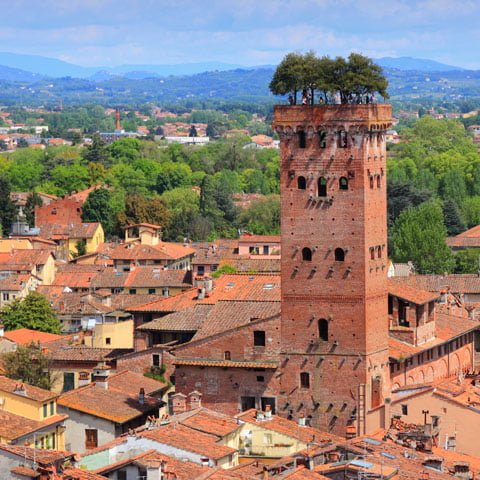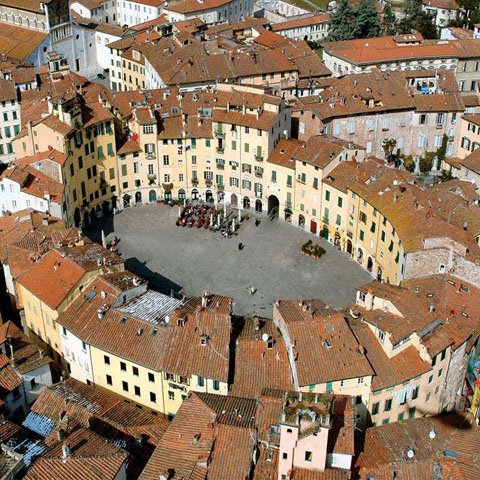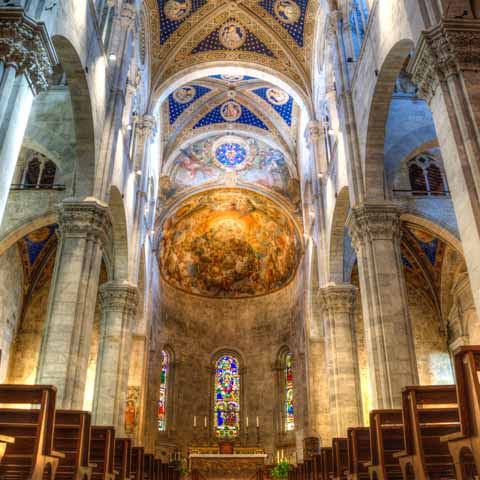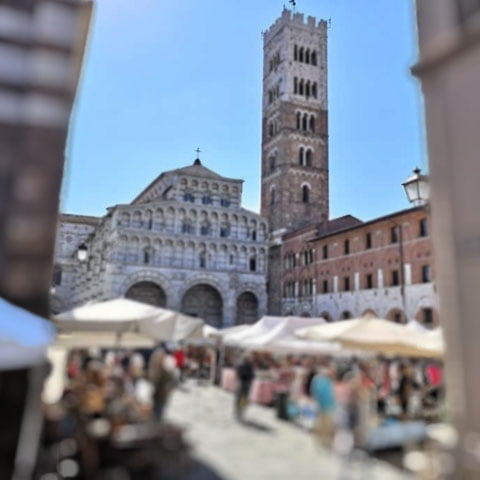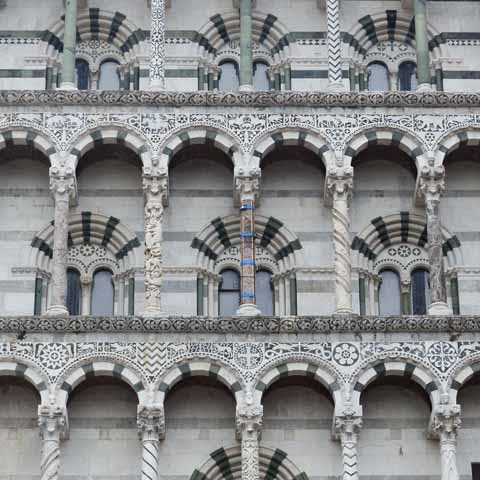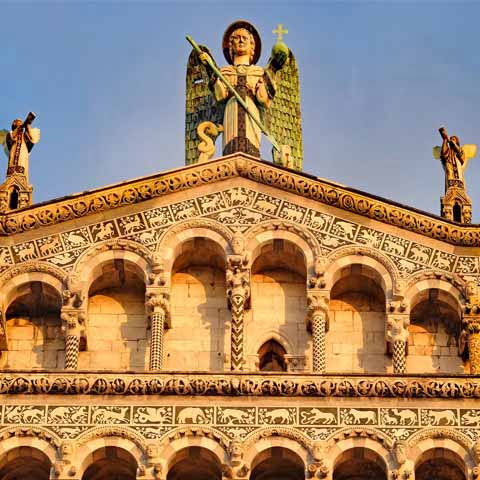Lucca is located in the Lower Valdarno plain between the Oltreserchio Mountains and Monte Pisano, a short distance from the left bank of the Serchio River. The charming Tuscan city is known for its sixteenth century defensive walls that remain intact. In fact, one of the favorite pastimes among locals and visitors alike is to walk or bike along the top of the city walls. Additionally, Lucca’s landscape is fairly flat compared to other parts of Tuscany, making it the perfect place to enjoy nice, long walks.
The historic city center features countless examples of splendid medieval architecture in the form of palaces, towers, and churches. Must-sees include the Duomo of San Martino, Torre Giunigi, the Basilica of San Frediano, and the main square, Piazza Anfiteatro, which was built on the sight of a Roman amphitheater and has retained the ancient structure’s elliptical shape.
Today, Lucca is truly a sight to be seen for travelers that would like to experience the authentic side of Tuscany.
PRESHISTORY OF LUCCA
Archaeological finds attest to the presence of a settlement in the area since the Iron Age.
There are two theories regarding the origin of the city’s name. According to some scholars, Lucca derives from the Celto-Ligurian root luk, which means “swampy place.” In the past, the area was in fact characterized by extensive marshes, which were also the cause of malarial fevers that plagued the local citizenry.
According to a more plausible etymological theory, Lucca derives from “sacred wood” (Latin: lucus), “cut” (Latin: lucare) and “luminous space” (leuk). Therefore, a luminous space obtained from a wooded area.
It is believed that Lucca could have been a station of the Ligurians, and then was subsequently occupied by the Etruscans in the fifth century. There is evidence of a Latin colony as far back as 180 BC, and under Emperor Augustus, Lucca was a Roman city part of Etruria.
Thanks to its position, Lucca was of great strategic importance as a city-fortress against possible attacks from the north, both during the Republican period of Rome and the Empire.
The first walls of the city date back to the Roman period. In 55 BC, Lucca served as the seat of the first triumvirate between Gaius Julius Caesar, Pompey the Great, and Marcus Licinius Crassus. The three men divided the conquered provinces and agreed on political offices. With this alliance they controlled the politics of Rome.
HISTORY OF LUCCA
After the fall of the Roman Empire, Lucca was occupied by the Goths and by the Byzantines. With the Lombard occupation of circa 570 AD, Lucca became the capital of the Lombard Duchy of Tuscia.
In 773, Charlemagne conquered the city, and Lucca flourished under the Carolingian dominion. Textile production and export of silk made the city known throughout Europe.
Later on, Lucca found itself located on the Via Francigena, the pilgrim route that connects Rome with Northern Italy and Europe, and was a stop for pilgrims on their way to Rome. This favored the construction of hospitals, castles, villas and churches that can still be visited today.
During the struggles between the Papacy and the Holy Roman Empire, Lucca sided with the Ghibellines, loyal to the Empire, against the Guelphs, loyal to the Church and the Pope.
In 1126, Lucca allied itself with Genoa against Pisa.
In 1200, Lucca was one of the most important cities on the peninsula. Throughout the 1300s, administrative and juridical power was in the hands of the great noble families, though internal conflicts for power did weaken the city, culminating in 1314 when Uguccione della Faggiola, Lord of Pisa, conquered Lucca.
However, thanks to the intervention of Emperor Charles IV, Lucca regained its autonomy in 1370 and chose a republican government. Subsequently, the thriving silk trade returned wealth to the city.
The year 1430 brought battles to the territory of Lucca, which was attacked by Florence. However, thanks to the intervention of the Sforza of Milan and Genoa, the Florentines were forced to give up the city.
The sixteenth century was a period of cultural and architectural development, during which the city’s reconstruction campaign began. The current walls of Lucca date back to this period, with construction beginning in 1504 and ending in 1645.
Lucca remained an independent and aristocratic republic until 1799 when it fell under French rule. In 1805, Napoleon became King of Italy and the Principality of Lucca and Piombino was established, governed by Elisa Bonaparte and her husband Felice Bacicocchi. This lasted until 1815, the year in which the Duchy of Lucca was created.
In 1817 the French domination ended and Lucca was passed to the Bourbons. In 1847, Lucca was annexed to the Grand Duchy of Tuscany, and in 1860, the town was finally annexed to the Kingdom of Sardinia and then the Unified Kingdom of Italy.
Thankfully, Lucca did not suffer grave damage during the two World Wars. Today, this historic city continues to be admired in all of its historic splendor by travelers from all over the world.
ARCHAEOLOGY IN LUCCA
The National Museum of Villa Guinigi is home to fascinating collections of art made in Lucca and the surrounding province. Visitors begin in the archeological section, which displays artifacts from the eighth century BC including items attributed to the Etruscans and Ligurians.
Travelers can also admire sacred objects from the medieval period up to the eighteenth century.
Also of interest is the Domus Romana archaeological site in the center of Lucca, which was discovered in 2012. Here visitors can see the evolution of construction techniques over 2,000 years of history. There are walls and Roman finds that date back to the first century BC in addition to objects and constructions from the Middle Ages and Renaissance. Among the most valuable finds is a fibula (brooch or clasp) of the Augustan age and a bronze sestertius (coin) portraying Emperor Tiberius. Very important is a terracotta frieze, from which the name of the Domus (House of the Child on a Dolphin) derives, since it depicts two children riding dolphins.
Travel Guides
The Tuscany Region of Italy
The Cities of Tuscany, Italy
